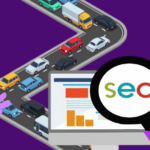Video security has become an important part of the overall security system. Today businesses prefer video surveillance over still CCTV security systems or any other security surveillance system. The reason why video security has picked up in recent years is that it helps in deterring crime, provides enough evidence in case a mishap or theft takes place, monitors, and gives accurate reports on the scenarios and it’s easy to maintain.
Apart from these, video analytics may help improve security in a variety of ways, including motion detection for perimeter security, facial recognition for access control, and artificial intelligence (AI) for object classification, to mention a few.
A consistent pattern emerges as we evaluate the possibility of video analytics in seven different industries. Analytics don’t simply help with security; they also work as a force multiplier, bringing new levels of awareness and knowledge to the table. They also strengthen the security professional’s position, allowing security to use its video investment to drive new levels of efficiency at all levels of the operation.
K-12 Schools
In a K-12 school, where a security officer may be tasked with keeping an eye on a huge and complex institution, analytics and AI can help that guard extend his or her reach. For example, if a child is left behind on the playground when everyone returned from recess, AI might be trained to distinguish between a child and an adult, so it isn’t mistakenly triggered if a teacher is on the playground versus a pupil.
Or if there is an active shooter on campus, AI might be trained to distinguish the appearance or sound of a gun and automatically inform authorities while also relaying the video. Simpler chores, such as taking attendance when kids enter the school or classroom, could be aided by analytics.
Universities
The sheer size of university and college campuses poses a security concern. University police agencies may have a big security footprint, including cameras and a monitoring centre to back them up. They do, however, have a lot of ground to cover. Analytics has the potential to be a force multiplier.
For example, facial recognition can be used as a ‘be on the lookout’ method to assist security in identifying persons of interest. Analytics can pick up on stalkers easily. A broad perimeter can also be secured using geofencing and other analytic methods. People may be leaping the fence at night to avoid the security gate, and analytics can act as a virtual barrier.
Healthcare
Video is most useful in the healthcare industry for securing entry and exit points, whether it’s to keep unwelcome individuals out of an emergency room or to keep dementia patients in and on-premise at a senior care home. Analytics solutions can alert operators when people enter or exit secure areas without following proper identification procedures, such as swiping a badge, or they can use facial recognition features to ensure that the person on camera who has earned access to a secure area is the person they claim to be.
Analytics can also be utilised to uncover potential risks that security staff might otherwise overlook. Left objects or ‘loitering’ analytics will help hospital security staff discover suspect packages or behaviours, especially if the warnings are issued in locations where there should be little foot movement.
Cannabis
According to research carried out by international security agencies, video analytics can assist cannabis growers in identifying potential hazards to their crop’s safety. “Mobile cameras that run along tracks mounted to the ceiling are installed in high-tech greenhouses. Analysing this footage can help in the early detection of pest or disease outbreaks, nutritional inadequacies, and unattractive growth patterns before they have a negative impact on a crop. It’s a method for security to make the most of its video investment while improving operational efficiency.
If, for example, the device was programmed to monitor quantities of the product changing hands at the point of sale, security might use analytics to help verify cannabis dealers comply with legislation. “It might ensure that consumers don’t acquire more merchandise than they are legally entitled to buy during the purchasing transaction.
To assist safeguard the perimeter at grow sites, analytics can be applied to remote video surveillance systems. Geofencing and motion-detection capabilities can also be used to extend the security force’s eyes over the growing and production processes.
Property Management
The video alone cannot provide complete security for a commercial property. Property management necessitates a blend of wide vision and in-depth knowledge. Beyond only photos, analytics can provide intelligence to help security personnel make the most of their time and cover more land.
You might have teenagers climbing on the building’s roof. They are causing damage to the roof, in addition to the overall liability issue. You can use analytics to find out where individuals go up on the roof and alert security. You’ll be notified in seconds, and perhaps you’ll be able to prevent the incident.”
When a parking lot fills up, analytics can discover patterns of behaviour.
This ensures that enough security coverage is available when and where it is required. By emphasising frequent traffic-flow patterns and sending out a notification to security officials when such patterns are interrupted, video analysis technologies can help security avoid theft from commercial buildings. This allows security to observe when products may be walking out the back door and respond in real-time, thanks to automatic warnings.
Critical Infrastructure
Consider the glowing dials of an oil refinery or a hydropower plant: Reminders that pressure and temperature are important safety factors. Security professionals can employ analytics to better monitor a large number of analogue sensors in real-time. If the pressure rises over a specific point as seen on the dial, an alert may be triggered. Point a camera at an analogue gauge, tell the analytics to look for threshold levels, and an alert can be triggered if the pressure rises above a certain point as seen on the dial.
Video can also be utilised to determine how certain aspects of the facility operations and can alert you when crucial components need to be replaced.
Workers, suppliers, and others who visit vital infrastructure installations are also tracked by security officers. When video analytics capabilities are combined with facial recognition surveillance systems, critical infrastructure can improve access control, keep security logs for entry and exits in specialised areas, and better manage visitors and contractors.
Manufacturing
In manufacturing, security is entrusted with ensuring that only the appropriate persons have access to certain areas, particularly sensitive production facilities and inventory depots.
Analytics can aid in this situation by making it easier for security to keep track of who enters and departs specialised areas. Video systems, when combined with facial recognition, can help secure better manage contractors and visitors.
Analytics can assist security in detecting abnormalities that could indicate a developing issue. Industrial customers will be interested in motion or object detection functions that may detect activity in a given region or pinpoint questionable objects in an area. Such skills could help security in ensuring that nothing suspicious or possibly harmful is left in their facilities, as well as being on the lookout for behaviour that could disrupt operations or cause possible events.
Manufacturers can also use video analytics‘ predictive capabilities to provide forecasts. Thermal imaging analysis, for example, can aid in the scheduling of maintenance downtime.
It’s precisely this kind of added value that makes video analytics appealing to a wide range of companies. Artificial intelligence, facial recognition, geofencing, and other technologies can help to improve security, making the security forces a significant actor in upgrading and increasing operations.
Summing-up
Any industrial organization’s primary priority is the safety of its employees and the security of its site. Today, companies have an urgent need to strengthen their overall security policies and systems to secure their people, property, and profits. You may simply improve the security of your industrial site by assessing or upgrading your current video surveillance system with the help of experienced security integrators.
There is no denying it. If you have a trustworthy security camera system monitoring your industrial site, your overall security posture will improve. Security cameras are a low-cost, high-efficiency solution for increasing productivity and protecting important assets while also boosting procedures and productivity. What should you look for when choosing the proper kind of security camera for your industrial site?
Getting in touch with the Shergroupies for a security solution will get a conversation going about what you require. To install a CCTV as part of our security plan, we first do a risk assessment of the region before examining all of the options available to you from our permanent and temporary CCTV solutions.
We enlist the support of our specialised partners to complete the installation and monitoring process, while we handle the service and assist you with any aspect of CCTV operation.
Click here to make a purchase | https://shergroup.com/product-page/security-cctv/
Contact us on
You can reach us |
By Phone | 020 3588 4240
Website | www.shergroup.com and you can chat to us from here
Email | [email protected]
Facebook | Check out Shergroup on this channel and message us
Twitter | Check out ShergroupChat on this channel and message us
LINKEDIN | Check out Shergroup’s LINKEDIN – and please FOLLOW us!
Instagram | Check out ShergroupChatter and follow us!






